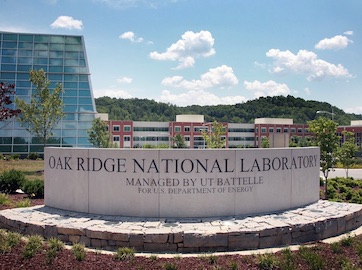Filter Results
Related Organization
- Biological and Environmental Systems Science Directorate (29)
- Computing and Computational Sciences Directorate (39)
- Energy Science and Technology Directorate (229)
- Fusion and Fission Energy and Science Directorate
(24)
- Information Technology Services Directorate (3)
- Isotope Science and Enrichment Directorate (7)
- National Security Sciences Directorate (20)
- Neutron Sciences Directorate (11)
- Physical Sciences Directorate
(138)
- User Facilities (28)
Researcher
- Yong Chae Lim
- Zhili Feng
- Eddie Lopez Honorato
- Jian Chen
- Rangasayee Kannan
- Ryan Dehoff
- Ryan Heldt
- Tyler Gerczak
- Vincent Paquit
- Wei Zhang
- Adam Stevens
- Akash Jag Prasad
- Brian Post
- Bryan Lim
- Calen Kimmell
- Callie Goetz
- Canhai Lai
- Christopher Hobbs
- Chris Tyler
- Clay Leach
- Costas Tsouris
- Dali Wang
- Fred List III
- James Haley
- James Parks II
- Jaydeep Karandikar
- Jiheon Jun
- Keith Carver
- Matt Kurley III
- Peeyush Nandwana
- Priyanshi Agrawal
- Richard Howard
- Rodney D Hunt
- Roger G Miller
- Sarah Graham
- Sudarsanam Babu
- Thomas Butcher
- Tomas Grejtak
- Vladimir Orlyanchik
- William Peter
- Yiyu Wang
- Yukinori Yamamoto
- Zackary Snow

A finite element approach integrated with a novel constitute model to predict phase change, residual stresses and part deformation.

System and method for part porosity monitoring of additively manufactured components using machining
In additive manufacturing, choice of process parameters for a given material and geometry can result in porosities in the build volume, which can result in scrap.

A pressure burst feature has been designed and demonstrated for relieving potentially hazardous excess pressure within irradiation capsules used in the ORNL High Flux Isotope Reactor (HFIR).

This invention is directed to a machine leaning methodology to quantify the association of a set of input variables to a set of output variables, specifically for the one-to-many scenarios in which the output exhibits a range of variations under the same replicated input

A new nanostructured bainitic steel with accelerated kinetics for bainite formation at 200 C was designed using a coupled CALPHAD, machine learning, and data mining approach.

Sintering additives to improve densification and microstructure control of UN provides a facile approach to producing high quality nuclear fuels.

Sensing of additive manufacturing processes promises to facilitate detailed quality inspection at scales that have seldom been seen in traditional manufacturing processes.

In order to avoid the limitations and costs due to the use of monolithic components for chemical vapor deposition, we developed a modular system in which the reaction chamber can be composed of a top and bottom cone, nozzle, and in-situ reaction chambers.

The technologies provide a coating method to produce corrosion resistant and electrically conductive coating layer on metallic bipolar plates for hydrogen fuel cell and hydrogen electrolyzer applications.

Welding high temperature and/or high strength materials for aerospace or automobile manufacturing is challenging.

